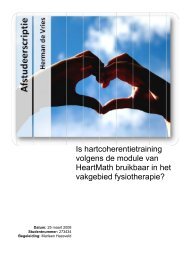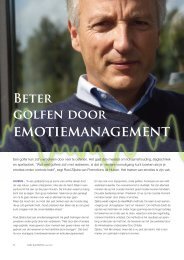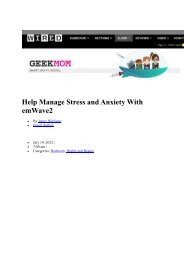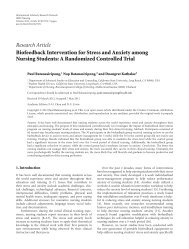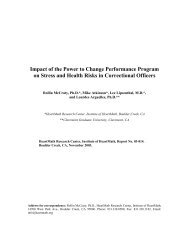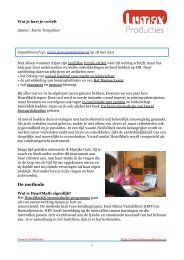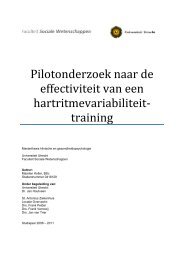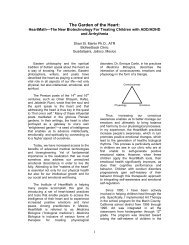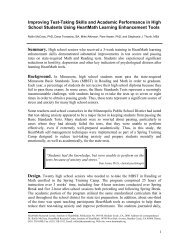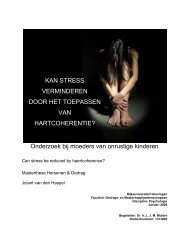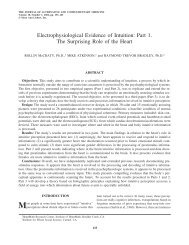Maximizing Performance while Reducing Risk - Heartmath Benelux
Maximizing Performance while Reducing Risk - Heartmath Benelux
Maximizing Performance while Reducing Risk - Heartmath Benelux
Create successful ePaper yourself
Turn your PDF publications into a flip-book with our unique Google optimized e-Paper software.
HeartMath ® Case Study<br />
<strong>Maximizing</strong> <strong>Performance</strong> <strong>while</strong> <strong>Reducing</strong> <strong>Risk</strong><br />
A Blood Pressure Study<br />
The new economy has ushered in an era of unprecedented change and transformation in our<br />
organizations – and the pace continues to accelerate. For some, this rapidly changing “new world”<br />
is challenging and stimulating; for many, it is extremely difficult. Recent scientific, medical and<br />
organizational research demonstrates that the turbulence of change and transformation and<br />
subsequent feelings of being overwhelmed, under-resourced, time-pressured and stressed substantially<br />
prevent individuals, teams and entire organizations from optimum performance.<br />
Symptoms indicating that the pressure associated with change is taking its toll on a workforce<br />
cover a broad spectrum. Some of these symptoms, e.g., indigestion, body aches, feelings of negativity<br />
and resentment may appear relatively insignificant or even unrelated to workplace efforts. Yet<br />
an accumulation of these “minor” symptoms often lead to far more dangerous conditions threatening<br />
both the health of the individual and the performance of the organization. Research has shown<br />
that a rise in the physical symptoms is a leading indicator of productivity losses.<br />
High blood pressure, or hyper-tension, is one of the most prominent public health issues in the<br />
U.S., affecting approximately one in four adults. High blood pressure is a major risk factor for<br />
death and disability, and has been strongly linked with decreases in cognitive performance,<br />
memory loss and deterioration of healthy brain tissue. 1<br />
A number of recent studies show that stress is a significant, yet manageable, contributor to hypertension.<br />
2 Hypertension has been shown to contribute to absenteeism, disability, impaired performance<br />
and loss of productivity. 3<br />
For the past ten years, HeartMath has been proving the link between the physical symptoms of<br />
stress and workplace effectiveness. As part of its program offerings, HeartMath delivers tools and<br />
techniques that individuals in organizations use to improve their business performance <strong>while</strong><br />
effectively managing work/life balance. Organizations benefit from increased productivity, reduced<br />
health care costs, lower absenteeism and improved retention.<br />
Purpose of the Study<br />
This study was to designed to determine whether training in Inner Quality Management ® (IQM)<br />
could reduce BP and simultaneously improve business performance in known hypertensive individuals.<br />
Numerous studies have demonstrated that the IQM techniques improve cardiovascular<br />
health, hormonal balance and immune function, as well as enhancing cognitive performance,<br />
communication and job satisfaction. 4<br />
In particular, a number of pilot studies conducted at Motorola, Shell and BP have demonstrated<br />
that executives with Stage 1 and Stage 2 hypertension who participated in an IQM training program<br />
were able to restore their blood pressure to normal values without the aid of medication after<br />
practicing the IQM techniques. 5<br />
In the present study, the impact of the HeartMath Inner Quality Management Program was investigated<br />
in a group of hypertensive individuals, using a randomized controlled trial design. Psycho-<br />
HeartMath and Inner Quality Management are registered trademarks of the Institute of HeartMath. Freeze-Framer is a registered trademark of Quantum Intech, Inc.
logical and performance-related parameters as well as heart rate variability measures were assessed<br />
concurrently with blood pressure changes to determine the overall impact of the program<br />
on employees’ health, well-being and effectiveness. This study also sought to determine the general<br />
feasibility of the implementation of such an intervention in an organizational setting as a means to<br />
improve health and performance in a hypertensive employee population.<br />
Study Design<br />
Thirty-eight hypertensive men and women from a Fortune 100 High Tech firm participated in the<br />
study. The participants were randomized into a target group that would first receive the training<br />
and a “waiting control” group, that would receive the training 90 days after the target group had<br />
been trained and data collected from both groups. All participants’ baseline BP was measured<br />
once a week for four consecutive weeks and psychometric data were also collected prior to training.<br />
The Personal and Organizational Quality Assessment-Revised (POQA-R), a broad-based<br />
assessment of psychological states and outcomes relating to business performance, and the Brief<br />
Symptom Inventory (BSI), a clinically valid measure of key indicators of psychological distress,<br />
were used. The psychometric data, additional BP and Heart Rate Variability (HRV) data was collected<br />
again from both groups approximately 90 days after the target group’s final training session.<br />
The same training was then delivered to the waiting control group.<br />
The Program & Training Delivery<br />
The IQM training was delivered in one full-day (8-hour) and two half-day (4-hour) sessions over<br />
three successive weeks. In addition to the class room material, participants were trained in the<br />
use of the Freeze-Framer ®, a software/hardware package which<br />
assists in the management of emotional and physiological responses and monitors Heart Rate<br />
Variability patterns (heart rhythms) at a personal computer.<br />
Blood Pressure Outcomes<br />
The reduction in systolic BP in the HeartMath (HM) treatment group was significantly larger than<br />
that in the waiting control (WC) group (p < .05). The HM group demonstrated a mean adjusted<br />
reduction of 10.6 mm Hg in systolic BP, as<br />
compared with the WC groups’ mean adjusted<br />
reduction of 3.7 mm Hg. For diastolic BP, the<br />
135<br />
HM group showed a mean adjusted reduction<br />
130.4<br />
130<br />
of 6.3 mm Hg, <strong>while</strong> the WC group demonstrated<br />
a mean adjusted reduction of 3.9 mm<br />
128.1<br />
125<br />
124.4<br />
Hg. The figure below displays the systolic and<br />
diastolic BP changes in both groups adjusted<br />
for baseline BP, age, gender, Body Mass Index<br />
120<br />
119.8<br />
and medication status.<br />
Because of the BP reductions they were able<br />
to achieve using the techniques, three participants<br />
in the treatment group who were regularly<br />
taking antihypertensive medications<br />
were able to reduce their medication usage,<br />
with their physicians’ approval, during the<br />
study period. Of these, one participant was<br />
permitted to discontinue medication usage<br />
entirely following completion of the study.<br />
Systolic BP<br />
Diastolic BP<br />
115<br />
85<br />
80<br />
75<br />
HeartMath<br />
82.9<br />
76.6<br />
HeartMath<br />
Control<br />
84.1<br />
Control<br />
80.2<br />
Pre<br />
Post<br />
Pre<br />
P ost
Psychological and <strong>Performance</strong> Outcomes—POQA-R Results<br />
The results of the POQA-R survey revealed numerous significant improvements in key indicators of<br />
both personal and organizational effectiveness in the HM group as compared to the waiting control<br />
group.<br />
Notably, for nearly all the items listed in the table, the HM group’s results improved <strong>while</strong> those of the<br />
control group declined over the same period of time. This suggests that the intervention not only<br />
stimulated positive changes but, potentially, may have also helped to reverse a trend toward decreased<br />
effectiveness in these measures.<br />
Improvement in a number of areas was substantial, with clear implications for organizational productivity<br />
and quality.<br />
I feel tired<br />
At the start of the study, 41% of employees in the HM group stated that they often or always felt tired.<br />
After the IQM training, this number had decreased to 6%.<br />
%<br />
60<br />
50<br />
40<br />
30<br />
20<br />
10<br />
0<br />
The quality of my work<br />
has improved<br />
6<br />
Trained<br />
40<br />
Pre Post<br />
Control<br />
31<br />
15<br />
Pre Post<br />
Doing my tasks well substantially<br />
contributes to my organization<br />
%<br />
Trained Control<br />
100 88<br />
80<br />
60<br />
40<br />
20<br />
0<br />
41<br />
Pre Post<br />
54 50<br />
Pre Post<br />
Before the training only 6% of employees in the HM group felt that<br />
the quality of their work had recently improved, <strong>while</strong> 40% noted<br />
improvements in work quality 3 months after the program.<br />
Nearly a quarter of employees in the HM group acknowledged feeling frustrated often or always at pretest,<br />
and 18% stated they felt like leaving the organization. At post-test, this ratio dropped to only 6% for<br />
both these items. In contrast, the percentage of employees in the WC group who stated they felt like<br />
leaving the organization increased from 21% to 43% over the study period.<br />
Heightened awareness of the relationship between individual<br />
performance and organizational success increased dramatically<br />
in the target group.<br />
%<br />
60<br />
50<br />
40<br />
30<br />
20<br />
10<br />
0<br />
%<br />
50<br />
40<br />
30<br />
20<br />
10<br />
0<br />
41<br />
Trained<br />
6<br />
Pre Post<br />
18<br />
Trained<br />
6<br />
Pre Post<br />
Control<br />
57<br />
50<br />
Pre Post<br />
I feel like leaving<br />
this organization<br />
Control43<br />
21<br />
Pre Post<br />
Further improvements in the HM group were measured in survey items dealing with areas that include<br />
communication, recognition, attitude toward the organization, positive outlook and value of work<br />
contribution, among others. The group also demonstrated substantial reductions in items reflecting<br />
burnout and physical stress symptoms.<br />
Conclusions & Recommendations<br />
This study demonstrates that the HeartMath Inner Quality Management program was effective in<br />
reducing blood pressure in a group of hypertensive employees over a 3-month period. Simultaneously,<br />
dramatic improvements were shown in employee attitudes and business performance. Not only are<br />
these employees healthier and less likely to be away from work for reasons relating to high blood<br />
pressure and its consequences, but they also feel less like quitting, find themselves better recognized
for their efforts by the company, are communicating better with each other <strong>while</strong> coping effectively<br />
with the pressures of their jobs and their lives.<br />
This study indicates that the IQM program can help to promote effective blood pressure management<br />
and improve well-being in hypertensive employees. This results in a healthier and more<br />
productive workforce <strong>while</strong> reducing losses to the organization due to cognitive decline, performance<br />
impairment, morbidity and premature mortality. The approach utilized in this study helps<br />
to establish a practical model that can be easily duplicated and expanded to make the benefits of<br />
this program available to larger populations.<br />
% attendees<br />
50<br />
45<br />
40<br />
35<br />
30<br />
25<br />
20<br />
15<br />
10<br />
5<br />
0<br />
Summary of Improvements Seen in Target Group<br />
24<br />
41<br />
Pr e<br />
Post<br />
6 6 6 6<br />
24<br />
Frustrat ed Tired Sleepless Muscle Tension Body Aches<br />
29<br />
47<br />
29<br />
1. Neurology, 1998. Journal of American Medical<br />
Association, 1995.<br />
2. Journal of HypertensIon, 1998. AmerIcan Heart<br />
Journal, 1998.<br />
3. Journal of Occupational and Environmental<br />
Medicine, 1999.<br />
4. American Journal of Cardiology, 1995. Stress<br />
Medicine, 1997.<br />
5. Watkins, A. The personal and business benefits<br />
of the Inner Quality Management Programme:<br />
Case Study 9, Oil Company 1. Hunter Kane<br />
Resource Management, Southampton, UK, 1999.<br />
Pre<br />
Post<br />
% attendees<br />
100<br />
90<br />
80<br />
70<br />
60<br />
50<br />
40<br />
30<br />
20<br />
10<br />
0<br />
6<br />
40<br />
Work Quality<br />
76<br />
94<br />
Manage time<br />
pressure<br />
53<br />
75<br />
I listen<br />
clos ely to<br />
co-w orkers<br />
50<br />
41<br />
We listen<br />
carefully to<br />
each other<br />
41<br />
88<br />
Doing tasks<br />
well = strong<br />
contribution<br />
29<br />
75<br />
My efforts<br />
make a<br />
difference<br />
Pr e<br />
Post<br />
% attendees<br />
90<br />
80<br />
70<br />
60<br />
50<br />
40<br />
30<br />
20<br />
10<br />
0<br />
18<br />
6<br />
I feel like<br />
quitting my<br />
job<br />
65<br />
81<br />
I appreciate<br />
my<br />
organization<br />
56<br />
73<br />
Supervisor<br />
appreciates<br />
my work<br />
65<br />
75<br />
My work<br />
objectives are<br />
clear<br />
47<br />
67<br />
My work is<br />
interesting<br />
14700 West Park Avenue<br />
Boulder Creek CA 95006<br />
831.338.8700<br />
www.heartmath.com
Results: Comparison Target to Control Group<br />
Scale Question Pre-IQM 3 Months Later<br />
Organizational Climate<br />
Value of Contribution My efforts make a difference in my organization Treatment 29% 75% Agree-Strongly Agree<br />
Control 57% 43%<br />
Value of Contribution Doing my tasks well substantially contributes Treatment 41% 88% Agree-Strongly Agree<br />
to my organization<br />
Control 54% 50%<br />
Value of Contribution My efforts do not go unacknowledged Treatment 53% 63% Agree-Strongly Agree<br />
Control 50% 21%<br />
Perceptions of There is tension between management and staff Treatment 31% 27% Agree-Strongly Agree<br />
Management<br />
Control 14% 31%<br />
Role Clarity My work objectives are very clear Treatment 65% 75% Agree-Strongly Agree<br />
Control 50% 36%<br />
Recognition My supervisor appreciates the way I do my work Treatment 56% 73% Agree-Strongly Agree<br />
Control 64% 31%<br />
Communication I listen closely to my co-workers Treatment 53% 75% Agree-Strongly Agree<br />
Control 79% 64%<br />
Communication We listen carefully to each other at work Treatment 41% 50% Agree-Strongly Agree<br />
Organizational Quality<br />
Control 50% 38%<br />
Attitude toward The success of my organization is important to me Treatment 76% 88% Agree-Strongly Agree<br />
Organization<br />
Control 69% 64%<br />
Attitude toward I am committed to my organization’s mission Treatment 76% 81% Agree-Strongly Agree<br />
Organization<br />
Control 57% 46%<br />
Quality of Work Recently, the quality of my work has improved Treatment 6% 40% Agree-Strongly Agree<br />
Control 31% 15%<br />
Quality of Work I strive for excellence in all I do at work Treatment 71% 75% Agree-Strongly Agree<br />
Control 71% 62%<br />
Job Satisfaction I feel like leaving this organization Treatment 18% 6% Agree-Strongly Agree<br />
Personal Quality<br />
Control 21% 43%<br />
Positive Outlook I feel relaxed Treatment 41% 76% Often-Always<br />
Control 36% 29%<br />
Positive Outlook I wake up and look forward to each day Treatment 59% 81% Often-Always<br />
Control 64% 46%<br />
Negative Outlook The actions of others get on my nerves Treatment 13% 6% Often-Always<br />
Control 7% 15%<br />
Anger I feel frustrated Treatment 24% 6% Often-Always<br />
Control 29% 38%<br />
Burnout I feel tired Treatment 41% 6% Often-Always<br />
Control 57% 50%<br />
Burnout I feel fatigued Treatment 35% 12% Often-Always<br />
Control 50% 43%<br />
Physical Symptoms I experience sleeplessness Treatment 24% 6% Often-Always<br />
Control 14% 15%<br />
Physical Symptoms I have muscle tension Treatment 29% 6% Often-Always<br />
Self-Management Competencies<br />
Control 21% 36%<br />
Emotional I manage time pressures well Treatment 76% 94% Often-Always<br />
Management<br />
Control 64% 69%<br />
Emotional It’s difficult for me to calm down after I’ve been upset Treatment 29% 0% Often-Always<br />
Management<br />
Control 29% 15%<br />
Self Esteem I like who I am Treatment 71% 94% Often-Always<br />
Control 79% 77%



